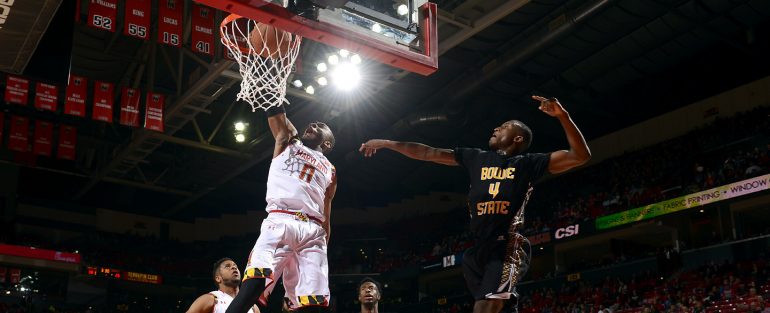COLLEGE PARK — While Maryland’s blowout win over Bowie State last month might not have been any legitimate indicator of where the Terps were after their first bye, it did perhaps signal a new trend in college basketball: mid-season out-of-conference scheduling.
The Feb. 9 matchup was the third instance this season of a school playing a team outside of its interscholastic athletic conference affiliations in January or February, a period traditionally reserved for unadulterated conference competition.
A couple of weeks ago, the SEC and Big 12 held their annual challenge more than a month after its usual slot in December to Monday Feb. 8 in women’s college basketball pitted the University of Connecticut and the University of South Carolina against each other.
Around the NCAA, varying reasons were offered from this departure from convention.
In College Park, the original intention was to schedule Bowie State for December, but due to a clear conflict with Maryland’s fall final examination period, the alternative was to schedule it during one of Maryland’s bye weeks in February.
“Hopefully this will allow us to keep our rhythm…and hopefully expand our bench a little bit,” Terps head coach Mark Turgeon said before the game with the Bulldogs. After a 93-62 victory orchestrated through an evenly balanced dosage of starters and reserve players, Turgeon was grateful for the opportunity for the team to get back on the court.
“It doesn’t matter who your opponent is. You still have to play a 40-minute game. They are going to play defense, we’re going to play offense,” Turgeon said.
It’s no big deal, if you ask the SEC.
“A lot of schools do this to fill byes in their schedule,” said SEC spokesman Craig Pinkerton.
In the case of the SEC Big 12 Challenge, the objective was to generate more exposure for the event by scheduling it during a time where other inter-conference challenges had concluded.
“During previous seasons we would usually have the challenge in December, however, it would get lost in all the other inter-conference games,” Pinkerton said. “We moved it later in the season this year, hoping that it would become a marquee event.”
Indeed, the reward was the highest Nielsen rating in the history of the Big 12-SEC Challenge when Kentucky played Kansas on Jan. 30.
The University of Connecticut’s women’s team usually schedules a non-conference opponent during the conference season.
“The last couple years, we have played South Carolina, and in years before that we have played Duke or North Carolina or Oklahoma,” said University of Connecticut Women’s Basketball spokesman Patrick McKenna. “ It’s just another chance to play a really good opponent on national television.”
The nationally ranked (then No. 2 ) Terrapins’ brief escape from Big Ten play to head across the Capital Beltway to face Division II-bound Bowie Bulldogs of the Central Intercollegiate Athletic Association (CIAA) was not only conceived as a good way to counteract a long bye week. It also presented another opportunity for the Terps to play local schools.
Last fall, Maryland took on Georgetown University and Mount St. Mary’s University – and beat them both.
“The idea was to stay fresh against a local team,” said University of Maryland men’s basketball spokesman Zach Bolno. “Since a lot of the student athletes are from the Maryland area, it offers a great chance to play against familiar foes.”
Although not certain about specifics for next season, Bolno said he was sure that meetings with other Washington area teams will be on the schedule, including a rematch against Georgetown at the Verizon Center for the 2016 Big Ten-Big East Challenge.

